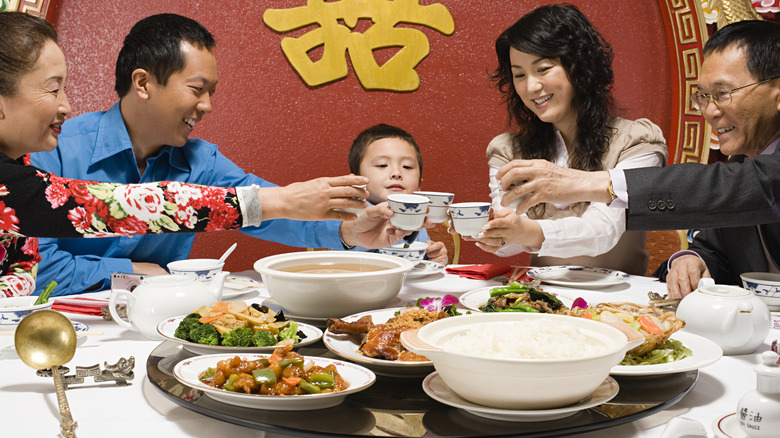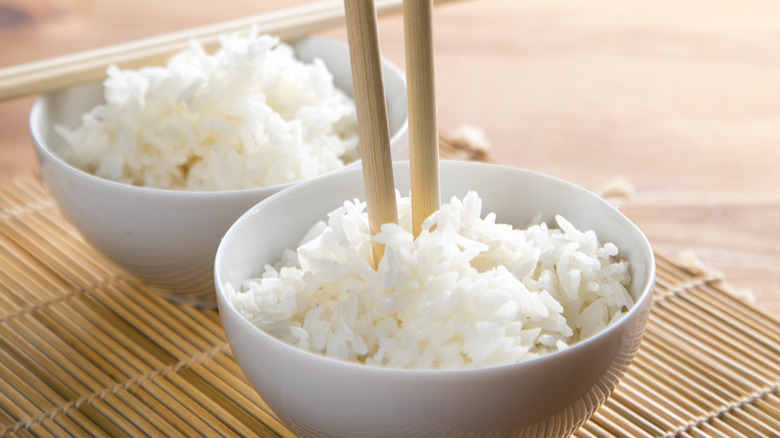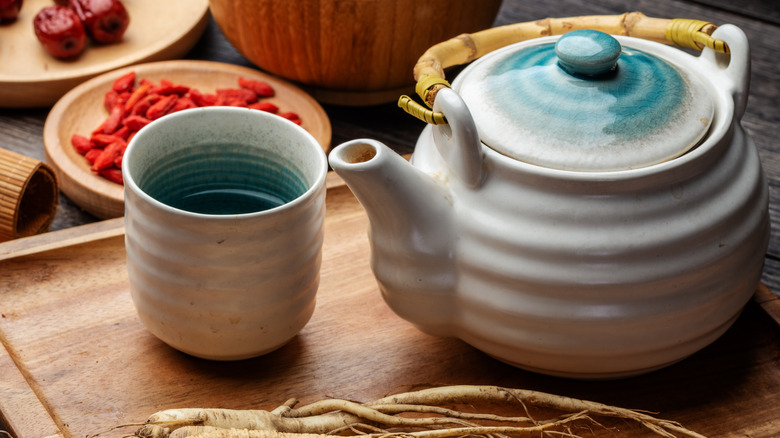The Chopsticks Restaurant Etiquette You Might Not Be Aware Of
When we eat at Chinese restaurants, we usually eat family-style. That is, we order plates for the whole table, and then share the dishes, everyone serving themselves from the communal plates. Eating family style is a scene that's familiar to many (excuse the pun), and is associated with heartwarming moments of social connection over shared food — as well as the occasional conflict over everything from dining etiquette to who gets the last crispy prawn.
With family-style dining, the portions are large — and in Chinese restaurants, dishes as diverse as dim sum and Peking duck are designed for sharing. Many are so irresistible that it's entirely understandable if your first instinct is to lunge in right away with your chopsticks to take your fill. Except, you shouldn't.
When sharing food, it's generally considered bad etiquette to use the chopsticks you're eating with to grab food from the communal dishes. The reason for this is hygienic: Those chopsticks have been in your mouth, so you shouldn't be poking around with them in food others are going to eat. It makes sense, and logically, the same goes for using your own knife, fork, or spoon to serve yourself from the center of the table. Instead, use a serving spoon or serving chopsticks to fill your plate, then eat from there, refilling as needed.
Different cultures, different chopstick etiquette
Chopsticks have existed for at least 5000 years, originating as sticklike cooking tools made from bone, not necessarily intended as eating implements. Interestingly, they are thought to have risen in popularity in parts of Asia due to a form of etiquette: From the 6th century, cutting meat at the dining table was seen as violent in China, and chopsticks became the civilized solution. This is the reason food is always served pre-sliced in Chinese restaurants (making it more chopstick-friendly in the process).
About a third of people worldwide use chopsticks daily. Some rules of chopstick etiquette are specific to certain cultures, while others are almost universal. Generally, anything that mimics knife-like action is often considered bad etiquette across chopstick-wielding cultures. It's best not to impale food with your chopsticks; similarly, avoid leaving chopsticks upright in a bowl of rice: This is associated with death in some Asian cultures. Famously an etiquette-filled culture, the Japanese frown on rubbing disposable chopsticks together. This practice is thought to remove wooden splinters, but it's also seen as a minor insult to the establishment: The implication is that their chopsticks are poor quality.
It's worth noting that Asia is not a chopsticks-only continent. Countries like Indonesia, India, and Thailand rarely use chopsticks, and only for certain noodle dishes. For this reason, spotting chopsticks on the table is Jet Tila's ultimate red flag when dining at a Thai restaurant.
The do's and don't of Chinese restaurants
There isn't a long list of things to remember in Chinese chopstick etiquette beyond not using your chopsticks to serve yourself from shared plates of food, and avoiding knife-like actions. Beyond chopsticks, however, there are plenty of other points of etiquette to watch out for when dining in a Chinese restaurant. Tea, which is commonly drunk with meals in Chinese culture, should be poured for other guests — you shouldn't refill your cup yourself. Age hierarchy is important in Chinese culture: If you're dining with elders, they should be the first to order, and the first to start eating. The guest of honor (or eldest), should be sat before other guests and should face the entrance.
It's also a great idea to try something new. Chinese cuisine is among the most diverse and delicious on earth. But Chinese food tastes different in America, and it's dominated by a few — admittedly tasty — dishes designed for the American palate such as kung pao chicken and fried rice. Enjoy a culinary adventure and potentially delight your wait staff in the process by asking about the restaurant's most authentic, traditional dishes and ordering something new and delicious.


